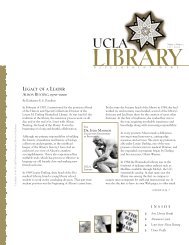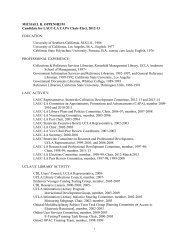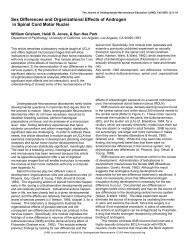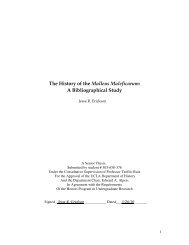Research Paper - UCLA Library
Research Paper - UCLA Library
Research Paper - UCLA Library
You also want an ePaper? Increase the reach of your titles
YUMPU automatically turns print PDFs into web optimized ePapers that Google loves.
of patriarchy and, equally important, to a monarch who had sons, removing the possibility of a<br />
repetition of the nightmare of succession” (Hyland 84). Public opinion regarding Elizabeth’s<br />
Gu 15<br />
reign was mixed at the time of her death and it was only after James proved himself to be a poor<br />
ruler uninterested in government affairs that the late queen’s stock began to rise again.<br />
IV. TRANSITIONS OF POWER: THE DECAY OF THE FAÇADE<br />
We must examine and attempt to characterize the specific cultural atmosphere of the<br />
early 1600s, from 1603 to 1606, in order to determine the significance of presenting the newly<br />
deceased virgin queen on stage in The Revenger’s Tragedy as Vindice’s murdered fiancé<br />
Gloriana. In doing so, it draws on contemporary historical accounts, portraiture, descriptions of<br />
processions and pageants, and other tracts. Through these contemporary representations of<br />
Elizabeth I, this thesis attempts to characterize a negative discourse surrounding Elizabeth in the<br />
early years after her death. Writings between 1603 and 1606, when The Revenger’s Tragedy was<br />
first performed, display both feelings of mourning over the queen and a sense of relief at the<br />
return to a male monarchy. It is to this discourse that The Revenger’s Tragedy responds to and<br />
participates in.<br />
Elizabeth I died on March 24, 1603 at the age of 69. Although the people mourned the<br />
Queen’s death, many also rejoiced in the triumph of a new king; the courtiers especially were<br />
eager to curry favor with the new regime and had subsequently forgotten or discarded their<br />
loyalty to the old one. For several days, the body of the old Queen was left unattended at<br />
Richmond where she died, and the apparent disregard for the treatment of Elizabeth’s cadaver<br />
immediately after her death is evidence of this shift in allegiance (Lee 113). In a manuscript<br />
narrative of the Queen’s death, Elizabeth Southwell, a blood relative and royal maid of honor to











